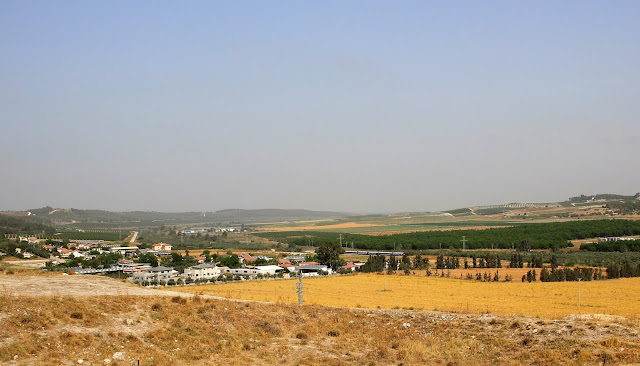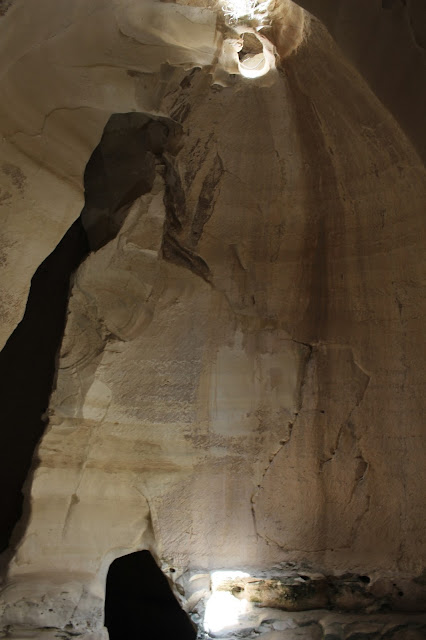Israel 2016, Day 11
Our morning began with a trip to the Shephelah, west of Jerusalem. The Shephelah sits between the broad, flat coastline and the hills and valleys of Judea/Jerusalem. It is made up of gently rolling hills separated by five valleys, four of which are seen on the map below. The valley not shown is the Guvrin Valley. All the valleys are potential approaches to Jerusalem but the Aijalon is the primary and easiest one to navigate, followed by the Elah.
Our first visit was to Beth Shemesh in the Sorek Valley. The Sorek Valley is one of the approaches to Jerusalem through the Shephelah but ends in a very deep valley just prior to the city that has come to be called "The Moat" for it's difficulty to navigate across.
 |
| The Sorek close to Jerusalem |
 |
| The tree in the middle of the horizon that stand by itself is the ancient site of Zora |
Personally, I like the idea that Samson was not an upright and moral man. Dr. G says he was a "He man with a she problem". Isn't his story far better when we realize that God used him regardless of his looks, strength and capability?
Looking to the north, we can see the part of the Sorek Valley we read about in 1 Sam 4-5. The Philistines battle Israel who brings up the Ark of the Covenant hoping the Ark would save them as if it was some sort of amulet (1 Sam 4:3). The Philistines capture the ark, which does not work out well for them (1 Sam 5). They send it back on a cart pulled by two cows. The cows pull the Ark through this portion of the Sorek.
Our next destination was Azeka overlooking the Valley of Elah, another western approach to Jerusalem, this one leading toward Bethlehem.
The Valley of Elah was strategic to Jerusalem and is the location of David's battle with Goliath (1 Sam 17). The Philistines gathered on the right and Judah on the Left.
David's defeat of Goliath is a perfect example of God's promises. Some would have us believe it's all about "defeating the giants in our lives" if we just have enough faith. Others would rather think it promises victory in all we do, regardless of how the situation looks. It's actually neither of those self-edifying lessons. It is all about God's promise to preserve His children and David's focus on Him rather than himself.
What do we gain from David's story? We are not promised victory in all we do. We're not promised that we will have victory over our giants. We are, however, promised that God will preserve us and sustain us if we keep our focus on Him.
David's proclamation concerning Goliath was that he would be defeated "...that all the earth may know that there is a God in Israel."
On to Beth Guvrin and the ruins of Maresha in the Gurvin Valley, another western approach to Jerusalem but not a very good one. Maresha was Micah's home town (Micah 1:1) and was defended successfully by king Asa (2 Chron 14:9-15). It was a town of commerce with olive presses, Columbarium caves and many cisterns. For various reasons, it became an underground city. We explored a Columbarium Cave. These were caves designed to house pigeons. The pigeons would produce fertilizer for the crops and food for the people.
We also visited a chalk cave nearby. The soft chalk was used for many things but the primary use was to make plaster.
The Lachish Valley was next and Tel Lachish which sits at the southern end of the Shephelah and was strategic to nearly all points north. Lachish is fourteen miles south of Jerusalem, eleven miles south of Bethlehem and twelve miles southwest of Hebron.
Lachish was dramatically captured by Joshua (Josh 10). Rehoboam fortified and expanded it. But, in 2 Kings 18-19, Sennacharib, king of Assyria captures it and threatens to attack king Hezekiah in Jerusalem (2 Kings 18-19). God delivers Israel supernaturally.
 |
| Lachish was heavily fortified including waht may have been one of the first six chamber gates built by Solomon. |
 |
| The Lachish Valley |
Here's a map of where we've been so far, just to give an idea of the are in which we've been traveling.




























No comments:
Post a Comment